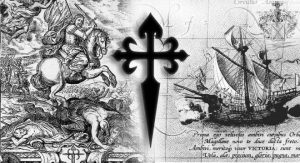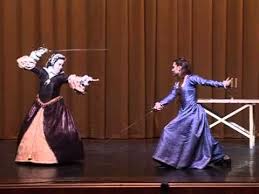History of European fencing
 So where did European fencing come from?
So where did European fencing come from?
Obviously not from books, as you understand …
Francisco Lawrence de Rada undertakes to answer this question, for generations over the centuries must understand how the history of fencing really looks.
Let us choose the year 1711 as the starting point of the presentation – this year is the year of publication of the treatise Francisco de Rada, commander of the Order of St. Santiago. So, I quote his words:
“300 years ago, – accordingly, this is approximately 1411 year – the real fencing system existed in full in Sicily and in Calabria.” What happened next? These people, who had knowledge of fencing science, went to war – went to conquer the continents, which later in history was called the “Spanish Conquista”.
After conquering the continents, the warriors returned to their native lands, home. These people were the cause of the emergence of such masters as Salvatore Fabrice, Giacomo de Grassi, Camillo Agrippa and others. Note: indeed, it takes about a hundred years and in 1508 the first (!) Treatises on fencing appeared in Venice, in general, as a phenomenon in history. But the treatises of Venice were written “for a reason”! If there were no Spanish Conquista, if its winners had not returned to their native lands, there could be no further talk of any treatises.
In particular, everyone respected Francesco Alfieri writes: “It only makes sense that the war and the duel have passed”. Undoubtedly, the words of the Maestro are true, but Alfieri himself – as well as de Grassi, Capo Ferro, Fabrice, etc. – never fought! These people did not go through a single war … so where did they get the necessary information from? Why do they even have it? The reason is simple: they learned everything from those who returned from the war, from those who took part in the Spanish conquest wars, from those who fought.
And so fencing occurs in Spain. In fact, nowhere else in Europe can it arise, since, apart from Spain, no one is waging more aggressive wars comparable to the Spanish ones. Documents never arose anywhere and could not have arisen (where else can they get it?)
Knights who have returned from the war and are the cause of the emergence of all subsequent “maestro”. It was from these knights that they studied, they acquired knowledge from them in the present way, they “gained intelligence” … Later, such “disciples” turned into “masters” who, in fact, had never taken part in any military battle!
Want to know what happened next? As easy as pie. Each of the new “Maestro” imagined that he is the only one who knows fencing thoroughly. This was the next step, as described by the commander of the Order of St. Santiago, de Rada. Everyone imagined that only he knew the secrets of fencing. There were even such precedents, as performed by Achille Marozzo, who demanded an oath from his students that “they would never tell anyone.”
But this is not the end. Further more. The disciples of Marozzo, Agrippa, de Grassi did not stop at what was achieved. You see, psychologically, “man” is such a “curious substance” that it does not want to learn from only one master. I want more benefits! And so did the generation of subsequent students. Someone first studied with Fabrice, then came to de Grassi (conditionally), then to the third “Maestro”, thereby collecting his own idea of fencing, learning the parts. And so they began to assemble their own, new systems, synthesizing in their own way the thoughts of the Maestro who taught them. This was the next step. Note that nothing changes (is not synthesized and does not undergo changes) only in Calabria and Sicily. In Europe, there is a real “boom”. The synthesis in the person of individual personalities gives rise to a real vinaigrette, above which the “new Maestro” rise and create new schools and new treatises. Pupils of the newly-minted maestros keep up with their predecessors – and the subsequent waves of “vinaigrette” and “synthesized in a new way” authoring systems give rise to more and more new maestros. And so it goes – to infinity. The commander of the Order of Saint Santiago, Francisco de Rada, defines all these fruits of “synthesis and compilation” quite accurately as “Destresa slag”.
In confirmation of the course of presentation, we quote from the treatise:
“… if you did not know, more than three hundred years ago this doctrine was practiced in the province of Calabria, the Kingdom of Naples and in Sicily with double weapons among some of our Spaniards, whose letters I carefully wrote down in the city of Barcelona in the house of my friend Dr. Don Pedro Soler, a famous knight in this principality and one of the fencers, with whom I spoke at the time. This teaching continued until he was mixed by such maestros as Aquila Marozzo, Giacomo di Grassi, Salvator Fabrice and others.
They completely ruled it out, because it’s a fake.
… As for the fact that, in their opinion, there are few or no rules, I reply: he considered such a situation as ordinary Destreza slag. ”




